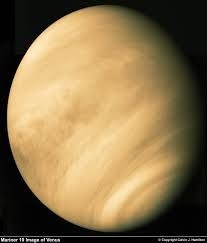Planet Profile
orbit: 108,200,000 km (0.72 AU) from Sun
diameter: 12,103.6 km
mass: 4.869e24 kg
History of Venus
Venus (Greek: Aphrodite; Babylonian: Ishtar) is the goddess of love and beauty. The planet is so named probably because it is the brightest of the planets known to the ancients. (With a few exceptions, the surface features on Venus are named for female figures.)
Venus has been known since prehistoric times. It is the brightest object in the sky except for the Sun and the Moon. Like Mercury, it was popularly thought to be two separate bodies: Eosphorus as the morning star and Hesperus as the evening star, but the Greek astronomers knew better. (Venus's apparition as the morning star is also sometimes called Lucifer.)
Since Venus is an inferior planet, it shows phases when viewed with a telescope from the perspective of Earth. Galileo's observation of this phenomenon was important evidence in favor of Copernicus'sheliocentric theory of the solar system.




